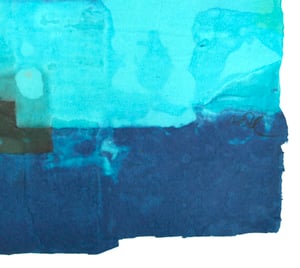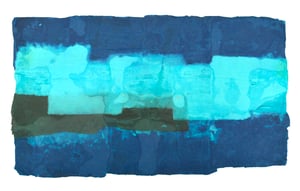Water Levels 13
£550.00
Water Levels 13 (2021)
31 x 54 cm
cotton fibre, pigment dyes
In 2014, I visited a section of canal between Johnson Lock and Limehouse Basin that had been drained to allow specialist bricklayers to repair damage to the canal wall. I was interested in signs of erosion of sand between the bricks at the highest point and was drawn to the idea of the walls of the canal as indicators of changes over time.
I’ve use mostly flat colours – jade and blues – to give the feeling of expanding lines. I wanted to give to the illusion of looking down and sideways, to create an abstract interpretation of a real view, which considers elements of temperature, time, air and landscape.
Added tension is created through the use of one strong colour – a light reflected, a moment of tension or a fixed point around which changes occur.
Note on the technique:
The cotton fibre pulp works are built up using layers of dyed pulp in a wet-on-wet or wet-on-dry, hand mould and deckle process. There is no glue in the mixture as the 'paper' holds together through the natural interweaving of the fibres themselves.
The pulp is made predominantly from cotton linters which is repeatedly mashed with water before different natural or synthetic, fibre-reactive pigment dyes are added to create the basic palette. In some cases, organic material is mixed with or embedded in the pulps, with the possibility of larger elements being stripped away when wet or dry leaving a 3D graffito-style impression in the revealed layers. An important feature is the uneven edges (deckle edges) that the process produces.
The natural light plays a big part in the drying process which can take 3 to 4 weeks. Natural sunlight and the right temperature help the chemical reaction between pigment and fibre resulting in stronger, high-density colours.



